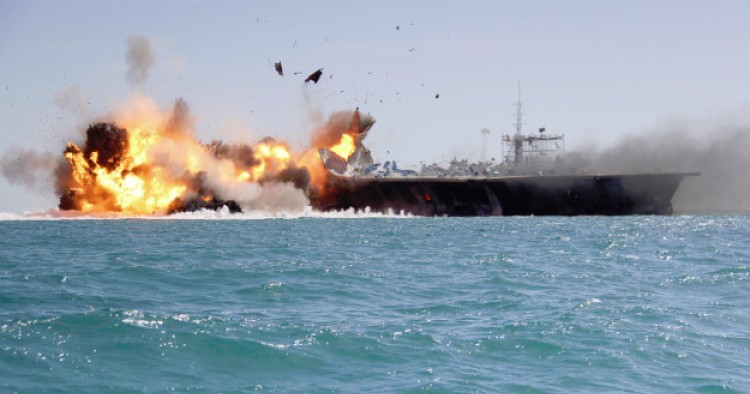On May 10, the top Iranian military official hinted that the country’s naval forces would use speedboats manned by “martyrdom-seeking combatants” against the U.S. Navy in case of a naval warfare in the Persian Gulf. “These boats are not just a piece of equipment; they are a culture,” Major General Mohammad Hossein Bagheri, the chief of staff of the Iranian Armed Forces, said at a conference on speedboats in Tehran. “The combatant that mans it is inspired by faith and trust in God and the martyrdom-seeking spirit of Ashoura [a major religious commemoration of the martyrdom of Prophet Muhammad’s grandson at Karbala]. He shuts his eyes to worldly attractions and steps into jihad [holy war] against the infidel front. He is ready to sacrifice his life,” Bagheri added.
He described the new Islamic Revolution Guards Crops (I.R.G.C.) speedboats as a “miracle” that will enhance Iran’s deterrence power against the United States and other foreign enemies. He continued: “We have encountered hostility and threat from America since the outset of the revolution’s victory [in 1979]. Successive administrations that have come to power in this country [the United States] have threatened the Islamic Republic of Iran with different words yet in similar ways. And these threats are primarily sea-based.” He warned that although the U.S. and its allies have extensive and powerful naval presence in the Persian Gulf and have taken advanced measures to protect them, “they are vulnerable and will suffer heavy losses and casualties.”
Comment: Bagheri’s remarks indicate that to counter the U.S. naval supremacy in the region, Tehran is employing “swarm tactics” and has put increased emphasis on fast-moving vessels that could inflict severe damage to U.S. naval forces in a potential war. In the past, the I.R.G.C. has blown up large target vessels mimicking U.S. aircraft carriers in mock exercises by missiles and swarms of Iranian gunboats in the Strait of Hormuz.
I.R.G.C. speedboats have increasingly been harassing American vessels in the Persian Gulf. In March, the U.S.N.S. Invincible and three British vessels were forced to alter course in the Strait of Hormuz when two Iranian speedboats approached them as close as 550 meters. U.S. officials say such incidents happen regularly and warn that Iranian provocations may lead to miscalculations and dangerous confrontations in the future. And last month, American officials said a U.S. Navy guided-missile destroyer had fired a warning flare to deter an I.R.G.C. vessel approaching it in the Persian Gulf. According to Lt. Ian McConnaughey, a spokesman for the Bahrain-based 5th Fleet, the Iranian vessel attempted to keep coming closer to the U.S.S. Mahan although the destroyer had changed direction to avoid the escalation.
Iran’s Foreign Minister Javad Zarif, however, defended the I.R.G.C.’s provocative move and questioned the presence of U.S. naval forces in the region. "Breaking: Our Navy operates in — yes, correct — the Persian Gulf, not the Gulf of Mexico. Question is what US Navy doing 7,500 miles from home," he tweeted, also attaching a map showing a distance of 7,592 miles between the Persian Gulf and Miami.
On February 1, the Trump administration put Iran “on notice” after a suicide vessel attack by Iranian-backed Houthi militants against a Saudi frigate in the Mandeb Strait. The U.S. Navy reported on 35 “unsafe” encounters with Iranian naval forces last year, compared to 23 in 2015.
The Middle East Institute (MEI) is an independent, non-partisan, non-for-profit, educational organization. It does not engage in advocacy and its scholars’ opinions are their own. MEI welcomes financial donations, but retains sole editorial control over its work and its publications reflect only the authors’ views. For a listing of MEI donors, please click here.













